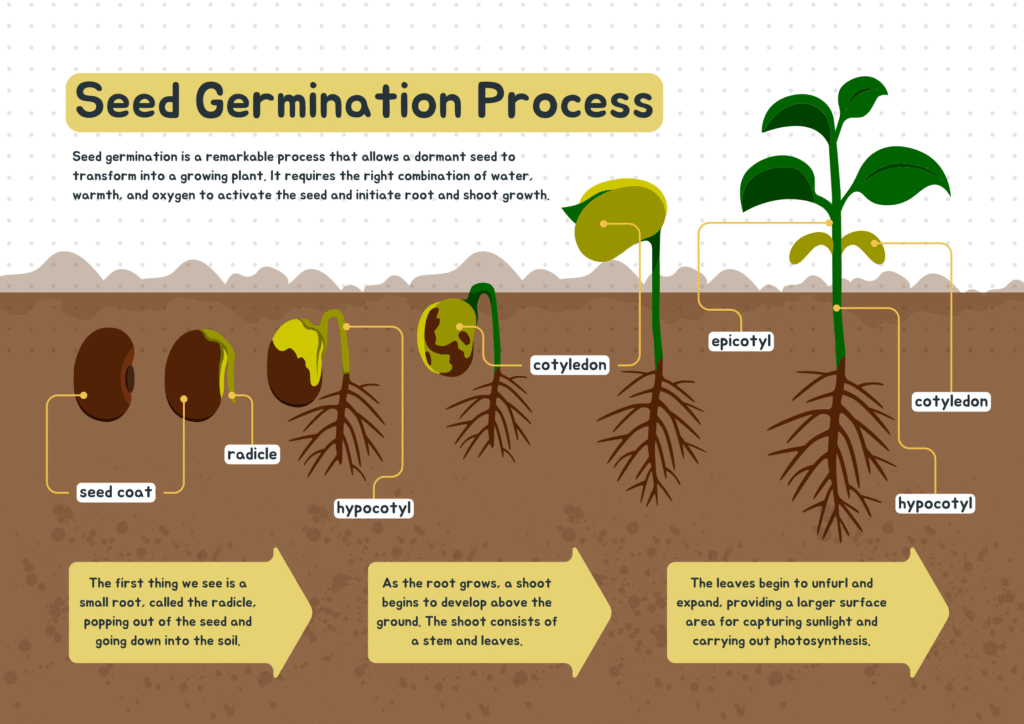Seed Germination How to Start Your Garden Right
Introduction to Seed Germination
Seed germination how to start your garden right. The enchanted moment when life begins is when seeds germinate. The first chapter of a flourishing plant begins when a little, inconspicuous seed comes to life and begins to produce roots and branches. Knowing how to steer this delicate procedure guarantees the greatest possible start for your garden.
Why is Germination Crucial for Gardening?

Without successful germination, there’s no garden—simple as that. Strong germination leads to robust plants, higher yields, and a lush, thriving garden. Poor germination? That spells frustration and empty garden beds. Getting this step right lays the groundwork for everything else.
Table of Contents
Choosing the Right Seeds for Success

Picking the right seeds isn’t just about grabbing a pretty packet off the shelf. It’s about understanding your environment, your goals, and your timeline.
Hybrid vs. Heirloom Seeds
Like cherished family recipes, heirloom seeds are passed down through the centuries and are incredibly diverse and flavorful. Conversely, hybrid seeds are produced for particular characteristics, such as increased growth or resistance to disease. Each has advantages, so pick the one that best fits your garden’s design.
Understanding Seed Packets
Seed packets are little treasure maps. They tell you everything you need to know: germination rates, planting depth, sunlight needs, and more. Read them carefully—they’re your first guide to success.
Essential Conditions for Seed Germination

Without the right conditions, seeds stay stubbornly asleep. Here’s what they need to wake up and stretch toward the sky:
Moisture
Life is water. Moisture activates biochemical reactions and softens the seed coat. However, too much water? The seed will be drowned. Instead of thinking “swamp,” think “damp sponge.”
Temperature
Seeds are picky about their thermostat settings. Cool-season crops like spinach germinate best around 50–60°F, while warm-season favorites like tomatoes want 70–85°F.
Oxygen
Seeds need to breathe! Compact, heavy soil can choke them. A loose, airy growing medium is a must to provide the oxygen seeds crave during germination.
The light
While certain seeds, like beans, thrive in the dark, others, like lettuce, need light to grow. Always perform a fast lookup or consult the seed packaging.
How to Test Seed Viability at Home

Are you curious as to whether the seeds in your drawer are still viable? Try a straightforward viability test. Ten seeds should be spread out on a moist paper towel, then sealed in a plastic bag and kept warm. If 7 out of 10 sprouts in a week or two, you’re good to go!
Pre-Germination Techniques to Boost Success

Sometimes seeds need a little nudge to get started.
Soaking Seeds
Soaking seeds in water overnight softens the seed coat and speeds up germination. Great for larger seeds like peas, beans, and sunflowers.
Scarification Methods
Got hard seeds like morning glories? Gently nicking them with sandpaper or a knife allows water to penetrate and wakes them up faster.
Stratification for Dormant Seeds
Some seeds need a fake winter to sprout. Place them in moist soil or paper towels inside the fridge for a few weeks to mimic natural cold conditions.
Preparing the Perfect Germination Medium

Forget heavy garden soil. Go for a light, sterile seed-starting mix. It holds moisture without becoming soggy and offers the delicate roots room to breathe.
Best Containers for Starting Seeds

Anything with drainage can be a seed container! You can buy seed trays or get creative with egg cartons, yogurt cups, or even cut-off milk jugs. Just make sure that any extra water can go out.
Creating the Ideal Indoor Germination Setup
Set seeds up for success indoors by using:
- Heat mats to maintain ideal soil temperatures
- Grow lights positioned close to seedlings
- Humidity domes to lock in moisture
It’s like creating a mini tropical paradise for your seeds.
Tips for Outdoor Germination in Various Climates
Time is crucial if you want direct sowing. Wait for the soil to warm up in colder climates. Plant seeds in early spring or late fall, when temperatures are more comfortable, if you live in a hot environment. For sensitive seeds, modest mulching can assist conserve moisture and regulate soil temperature.
Step-by-Step Guide to Sowing Seeds
- Fill containers with moistened seed-starting mix.
- Plant seeds at the recommended depth.
- Lightly cover and firm the soil.
- Mist gently with water.
- Keep warm and moist until germination.
Follow the Goldilocks rule: it should be just right—not too wet, nor too dry!
How to Water Seeds the Right Way
Use a spray bottle to mist gently, or bottom-water by placing seed trays in a shallow pan of water. Harsh streams from watering cans can dislodge seeds before they even get a chance to grow.
Troubleshooting Common Germination Problems
- Seeds not sprouting? Check if they’re too old, too deep, or too dry.
- Mold growing? Improve airflow and reduce humidity.
- Leggy seedlings? They’re stretching for light—bring your grow lights closer!
Stay observant and tweak your setup as needed.
How to Take Care of Young Seedlings After They Germ
When the seedlings show up, the game is on! Take off the humidity covers, water a little less, and let there be lots of light. To fortify stems and ward against fungal infections, introduce a little fan breeze.
How and When to Plant Seedlings Outside
Harden off seedlings by increasing their daily exposure to outside conditions before putting them outside. They become more resilient and avoid transplant shock as a result.
When transplanting, pick an overcast day or evening to minimize stress and handle seedlings by their leaves rather than their stems.
FAQs
Q1. How long does seed germination usually take?
It depends on the plant, but most seeds sprout within 5–14 days under ideal conditions.
Q2. Can I use regular potting soil for starting seeds?
It’s better to use a light, sterile seed-starting mix to avoid diseases and give tender roots a good start.
Q3. Should I fertilize seeds right after they sprout?
Nope! Wait until seedlings develop their first true leaves, then use a diluted, gentle fertilizer.
Q4. What if my seeds mold before sprouting?
Reduce moisture, improve ventilation, and try using a cinnamon sprinkle as a natural antifungal.
Q5. How deep should I plant my seeds?
General rule: plant seeds twice as deep as their diameter. Always double-check instructions for specific seeds.





